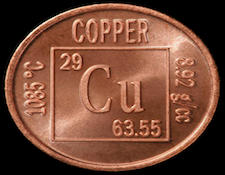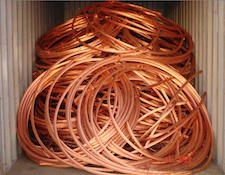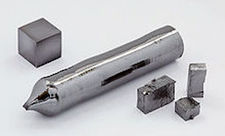It’s the time of year for saving money!
I wrote, last time, about the metal (the circuit board traces, point-to-point wiring, and, where appropriate, even the chassis grounds) that’s used in our audio equipment and as the conductors in the cables we use to hold everything together. In doing so, I concentrated (as I had in earlier installments of this series) on just two characteristics; its conductivity/resistivity (same coin, opposite sides) and its ability to take and hold a magnetic charge, and ignored its structural and appearance aspects and its ability to conduct and radiate heat, which IS important in amplifiers, other hot-running electronic components or systems, and in tubes and other output devices that may, themselves, be fitted with metal fins or heatsinks for cooling.
 I also picked-up, once again, the belief of many audiophiles, including me, that different metals, when used as conductors, can and often do have their own characteristic effect on the sound of our systems, and I gave, after eliminating simple resistance as a factor, two common (but admittedly often-challenged) reasons why that might be the case: Those reasons were possible distortion of the metal crystals of the conductors in the process of making wire by rolling or drawing raw copper (or silver) down to the desired size (diameter or AWG gauge), and the possible inclusion of thin films (or the equivalent) of semi-conductive oxide “micro-diodes” (usually oxides of copper, but with silver oxides also possible) between the crystals of the conductive material acting to “filter” or otherwise alter signal flow. I also added a third possible reason, which was that some of the oxides can also be “diamagnetic” – meaning that they can take-on a magnetic charge OPPOSITE TO the charge of a magnetic field energizing them – and said that that could also affect and change the characteristic “sound” of a signal passing through the conductors.
I also picked-up, once again, the belief of many audiophiles, including me, that different metals, when used as conductors, can and often do have their own characteristic effect on the sound of our systems, and I gave, after eliminating simple resistance as a factor, two common (but admittedly often-challenged) reasons why that might be the case: Those reasons were possible distortion of the metal crystals of the conductors in the process of making wire by rolling or drawing raw copper (or silver) down to the desired size (diameter or AWG gauge), and the possible inclusion of thin films (or the equivalent) of semi-conductive oxide “micro-diodes” (usually oxides of copper, but with silver oxides also possible) between the crystals of the conductive material acting to “filter” or otherwise alter signal flow. I also added a third possible reason, which was that some of the oxides can also be “diamagnetic” – meaning that they can take-on a magnetic charge OPPOSITE TO the charge of a magnetic field energizing them – and said that that could also affect and change the characteristic “sound” of a signal passing through the conductors.
From there, I went on to talk about metal purity as it is expressed in the number of nines (or “N”s) used to describe it (99.99% pure, “six nines” pure, 6N, 4N, etc.) and I said that, although I ultimately bought 99.9999% (six nines) pure copper for the cables to be made by XLO, the cable company I founded, I was never able to find anywhere – any company or any university or business laboratory — in the United States that could provide me at that time with an independent assay to corroborate the purity claims made by its Japanese manufacturer. Even so, on direct listening comparison with other wires of lesser claimed purity, the claimed “ultra-pure” wire samples that we had ordered did sound better, so that was what we used.
Now, in 2016, twenty-five years later, another Japanese company, JX Nippon Mining and Metals is not only claiming to be able to provide copper ONE THOUSAND TIMES as pure as what we originally used ― 9N , or 99.9999999% ― but to have the ability to prove it with the “Glow-Discharge Mass Spectrometry” (GDMS) process, which they say allows similar microanalysis of any element at all.
 I have no doubt that such super-duper-ultra-pure copper will be better than our original 6N, but I wonder if the improvement will be audible and I wonder if it will be sufficient to justify the undoubted increase in cost. And I still wonder, even as I did back then, whether any improvement that there might be will be as a result of the greater purity of the metal or of something else entirely, of which the greater purity is only a causative or incidental part:
I have no doubt that such super-duper-ultra-pure copper will be better than our original 6N, but I wonder if the improvement will be audible and I wonder if it will be sufficient to justify the undoubted increase in cost. And I still wonder, even as I did back then, whether any improvement that there might be will be as a result of the greater purity of the metal or of something else entirely, of which the greater purity is only a causative or incidental part:
At the end of the last article, I said that there might be a single answer to the question of why purer metals sound different that would, at the same time, effectively deal with all three of the possible answers (crystal distortion, micro-diodes, and diamagnetism) that I had mentioned earlier, and I said that it might have to do with the process by which the purest metals are produced.
Although there are undoubtedly variants on it, and although it certainly is (and has been) known by different names, the original (and still most commonly used) process for isolating the very purest metals was known as “zone refining” or “zone melting”, and was developed by William Gardner Pfann, of Bell Labs, as a method for producing high purity materials (initially semiconductors), for the manufacturing of transistors.
As it has been used for wire manufacture, the process can be very simple, with one of the simplest approaches being just to slowly push a bar or rod of copper (or silver or whatever other material) into a hole in the side of a very hot (ceramic) crucible. As it enters the crucible, the metal melts and turns to a liquid, which fills the crucible up to the point of one or more “run-off” holes of a diameter designed to produce whatever wire gauge is desired. Then, because whatever impurities are present will tend to concentrate and remain IN THE CRUCIBLE at the point of greatest heat (to be removed later, all at once at the end of the process), what flows out of the run-off holes will be purified metal that can either be used “as is” or can be re-run through the purification process as many times as desired until any desired level of purity has been achieved.
 For reasons that must be obvious, this process is also known as “continuous casting” (as in “Ohno Continuous Casting” a patented Japanese version) and is not only known to produce, in copper, metal of exceedingly high purity (Ohno calls it “PCOCC”, for “Pure Copper, Ohno Continuous Casting), but to produce, to make up that metal, individual copper crystals claimed to average125 meters (410.105 feet) in length. That’s more than 164,000 times as long as the crystals in “ordinary” copper, which is said to contain some 400 crystals PER FOOT, and means that, if it’s true, there will be 164, 000 times FEWER crystal junctures for micro-diodes to form at (thus at least greatly reducing the possibility diode-related signal loss or modification) and, because the metal is “cast” to size instead of being rolled or drawn to size, what few crystals there are WON’T be subject to potentially-signal-altering distortion, bending or breakage.
For reasons that must be obvious, this process is also known as “continuous casting” (as in “Ohno Continuous Casting” a patented Japanese version) and is not only known to produce, in copper, metal of exceedingly high purity (Ohno calls it “PCOCC”, for “Pure Copper, Ohno Continuous Casting), but to produce, to make up that metal, individual copper crystals claimed to average125 meters (410.105 feet) in length. That’s more than 164,000 times as long as the crystals in “ordinary” copper, which is said to contain some 400 crystals PER FOOT, and means that, if it’s true, there will be 164, 000 times FEWER crystal junctures for micro-diodes to form at (thus at least greatly reducing the possibility diode-related signal loss or modification) and, because the metal is “cast” to size instead of being rolled or drawn to size, what few crystals there are WON’T be subject to potentially-signal-altering distortion, bending or breakage.
Could it be that the “better sound” that people claim to hear from purer metal is real, but that it results NOT from the greater purity of the metal, but from the different crystal structure that the process of producing it creates?
More on this and on another different but related issue next time.
See you then.






